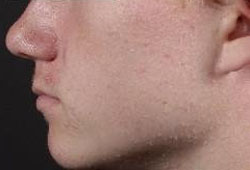Resumen
Definición
Anamnesis y examen
Principales factores de diagnóstico
- presencia de factores de riesgo
- lesiones cutáneas
Otros factores de diagnóstico
- sensibilidad en la piel
- dolencias sistémicas
Factores de riesgo
- adolescencia o adultos jóvenes
- predisposición genética
- piel grasosa/aumento en la producción de sebo
- uso de determinados fármacos
- uso de terapia hormonal masculinizante
- enfermedades del sistema endocrino
- factores dietarios
- sexo femenino
- obesidad/resistencia a la insulina
- exposición a hidrocarburos aromáticos halogenados
Pruebas diagnósticas
Primeras pruebas diagnósticas para solicitar
- diagnóstico clínico
Pruebas diagnósticas que deben considerarse
- evaluación hormonal
- cultivo bacteriano
Algoritmo de tratamiento
acné leve: no embarazada
acné moderado a grave o acné resistente al tratamiento estándar: no embarazada
embarazadas
Colaboradores
Autores
Robert P. Dellavalle, MD, PhD, MSPH
Professor of Dermatology and Public Health
University of Minnesota Dermatology Department
National Dermatology Program Director
US Department of Veterans Affairs
Minneapolis
MN
Divulgaciones
RPD has received editorial stipends (Journal of Medical Internet Research Dermatology (JMIR Dermatology)), royalties (UpToDate), and expenses reimbursement (Cochrane). RPD is an editor-in-chief of JMIR Dermatology, a joint coordinating editor for Cochrane Skin, a dermatology section editor for UpToDate, a social media editor for JAAD, and a coordinating editor representative on the Cochrane Council. He is a Cochrane Council Co-Chair, and serves as the National Dermatology Program Director for the US Department of Veteran Affairs.
Torunn E. Sivesind, MD
Dermatology Resident Physician
University of Colorado Anschutz School of Medicine
Aurora
CO
Divulgaciones
TES previously received fellowship funding from Pfizer and the National Institute of Health; TES previously served as an editorial board member-at-large for the Journal of Medical Internet Research Dermatology.
Agradecimientos
Professor Dellavalle and Dr Sivesind would like to gratefully acknowledge Dr Madeline Adelman, Dr Romerio Rodriguez, Dr Sarah Shangraw, Dr Mark Naftanel, Dr Yolanda Rosi Helfrich, and Dr Amanda Howland, previous contributors to this topic. The authors would like to thank Dr John Barbieri for his review of the topic. JB has received consulting fees from Dexcel Pharma.
Divulgaciones
SS, MN, YRH, and AH declare that they have no competing interests. MA has received fellowship funding from the Pfizer Global Medical Grant, RR receives fellowship funding from the National Institute of Health.
Revisores por pares
Gina Taylor, MD
Resident
Department of Dermatology
SUNY Downstate Medical Center
New York
NY
Divulgaciones
GT declares that she has no competing interests.
Gillian Murphy, MD, FRCPI, FRCP, Edin
Consultant Dermatologist
Dermatology
Beaumont Hospital
Dublin
Ireland
Divulgaciones
Not disclosed.
Agradecimiento de los revisores por pares
Los temas de BMJ Best Practice se actualizan de forma continua de acuerdo con los desarrollos en la evidencia y en las guías. Los revisores por pares listados aquí han revisado el contenido al menos una vez durante la historia del tema.
Divulgaciones
Las afiliaciones y divulgaciones de los revisores por pares se refieren al momento de la revisión.
Referencias
Artículos principales
National Institute for Health and Care Excellence. Acne vulgaris: management. Dec 2023 [internet publication].Texto completo
Reynolds RV, Yeung H, Cheng CE, et al. Guidelines of care for the management of acne vulgaris. J Am Acad Dermatol. 2024 May;90(5):1006.e1-30.Texto completo Resumen
Thiboutot DM, Dréno B, Abanmi A, et al. Practical management of acne for clinicians: an international consensus from the Global Alliance to Improve Outcomes in Acne. J Am Acad Dermatol. 2018 Feb;78(2 suppl 1):S1-23;e1. Resumen
Artículos de referencia
Una lista completa de las fuentes a las que se hace referencia en este tema está disponible para los usuarios con acceso a todo BMJ Best Practice.

Diferenciales
- Acné keloidalis nucal
- Erupciones acneiformes
- Cloracné
Más DiferencialesGuías de práctica clínica
- Guidelines of care for the management of acne vulgaris
- Acne vulgaris: management
Más Guías de práctica clínicaFolletos para el paciente
Acne
Más Folletos para el pacienteInicie sesión o suscríbase para acceder a todo el BMJ Best Practice
El uso de este contenido está sujeto a nuestra cláusula de exención de responsabilidad